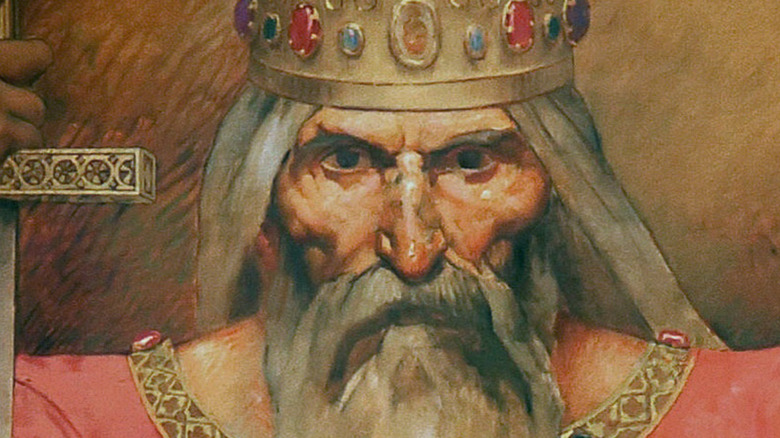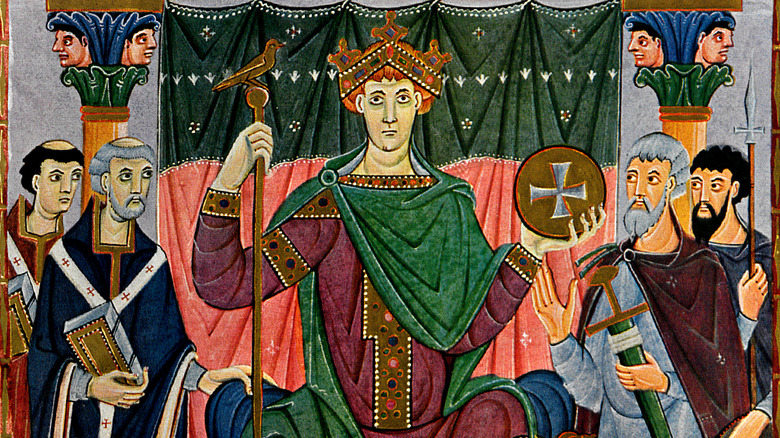The Bizarre Conspiracy That Says Charlemagne Never Existed
Here's a commonplace scenario for you: Imagine you wake up in the morning and flick your phone alarm to snooze. Ten minutes later you wake up again, groan when you look at the time, and compulsively start to flick through messages. You catch yourself before it gets too late, mutter "fine," roll out of bed and plod off to whatever step is next. For some it might be coffee, for others brushing one's teeth. Bit by bit you get assembled for the day. Showers are taken, deodorant is applied, clothes are donned, and if you've got to commute, you start your car or grab the train or bus. And when you open your calendar to check the day's schedule, you glance at the date. The year is 1725. Otherwise, nothing is different.
This is what's known as the "Phantom Time Hypothesis," a fringe historical theory put forward by German historian Heribert Illig in 1991, per All That's Interesting. We hesitate to use the word "theory," however, lest we draw into unscrupulous light actual, data-driven research far more worthy of the word. At this point the Phantom Time Hypothesis has been all but crushed as anything remotely resembling truth, but that doesn't mean it isn't fun to talk about. Besides, we get to learn some real history while witnessing the misleading depths of pet beliefs. The general gist of the whole thing? The years 614 to 911 C.E. never happened, and the legendary Frankish king Charlemagne never existed.
The Phantom Time Hypothesis
Plenty of websites like Medievalists.net lambaste the Phantom Time Hypothesis and talk about "why it is so dumb." And yes, it is. We won't even begin to pretend that it's valid. What about the stars and their movement in the sky, as Forbes points out? What about Halley's Comet and its regular 76-year journey around the sun, as NASA describes? What about sedimentary layers in Earth's rock that define different eras of time, and changes in the molecular composition of Earth's soil due to human activity (per the United States Geological Survey and Phys.org, respectively)? What about tree rings? What about regions of Earth outside of Charlemagne's sphere of influence, like China, that kept its own measurements of time that corroborate our collective historical timeline (per IFL Science)?
To all this Heribert Illig just said, "Nah." He asked readers to be "patient, benevolent, and open to radical new ideas," as ZME Science says. He put forth a dumb theory dressed in intelligent clothes, centered on something so dull that not many people could pay attention: dates, numbering, and basic math. Then, in 1995, Dr. Hans-Ulrich Niemitz expanded on the idea and published a paper titled "Did the Early Middle Ages Really Exist?," as Thought Catalog explains. "Between Antiquity (1 A.D.) and the Renaissance (1500 A.D.)," he wrote, "historians count approximately 300 years too many in their chronology." So those "Dark Ages," in other words? According to the Phantom Time Hypothesis they're more like the "Non Ages."
A holy conspiracy
To understand Heribert Illig's belief in fake historical time we've got to go back about 1,000 years (or 700, to Illig). To do so, let's zoom in on the reign of the Holy Roman Emperor Otto III, from 996 to 1002 C.E. He ruled amid an absurd entanglement of European power struggles, and considered himself equal parts the "emperor of the world" and "servant of Jesus Christ," as Britannica cites. In a matter of years he'd crossed the Alps, secured the election of his cousin as pope, went to Rome, executed the guy who'd chased his cousin away, deposed that guy's pope, and when his cousin died, installed yet another pope, Sylvester II, who had been his tutor. Then in 1000 C.E. he made a pilgrimage to the "mystical archbishop" Adelbert of Prague. That's just a sample.
Gizmodo picks up the tale from here. Illig believed that Otto III and Sylvester II had conspired during Otto's rule. Rather than Otto ruling over a dull set of regular years, they wanted him to oversee the momentous turn of the millennium, and symbolically connect him to the birth of Christ. So Otto's pilgrimage, for instance? It actually happened in 703 C.E. (full timeline on Twitter). The two men scrubbed historical records, rewrote dates, and even invented Charlemagne as an idealized, King Arthur-like paragon of power and Christian virtue. Then, they said that Otto III had taken the throne on the date of the fictional Charlemagne's coronation, Christmas Day.
Some garbled papal math
Okay, you might be thinking. Surely there's proof behind such claims? Not really. Absolute leaps of reason? Yes. Illig's initial, original idea comes from a supposed discrepancy in our calendars dating back to 1582 C.E. Back then, as ThoughtCo. states, Pope Gregory XIII attempted to fix the previous calendar system, the Julian calendar, and replace it with his own self-named Gregorian calendar. The Julian calendar — named after Julius Caesar — had been around since 46 B.C.E., and attempted to synchronize our annual calendar with an actual solar year, i.e., how long it takes to actually go around the sun. To do so, the Julian calendar implements a feature we're all familiar with: leap years. Every fourth year gets an extra day.
The only problem? The Julian calendar isn't totally accurate. We say one year equals 365 days, but it's actually 365 days, 5 hours, 48 minutes and 46 seconds. Every year goes over by 11 minutes, and so every 128 years we gain one day. Pope Gregory XIII tried to fix this problem by adjusting all the extra days that had accumulated over time. Since the Julian calendar was instituted in 46 B.C.E., that equaled 13 days by 1582 C.E. Gregory, though, as IFL Science explains, only adjusted things by 10 days. This is all it took for Illig to think, "Hey, what if that wasn't a mistake, but was intentional? What if the pope didn't include those three days because that time didn't exist?"
Charlemagne the unreal
So yes, that's all it took. A mathematical mistake made by Pope Gregory XIII lead to the Phantom Time Hypothesis. Never mind that if the church was trying to cover up 297 years of fake history, why would its pontiff in 1582 C.E. be suddenly scrupulous about accurate time-keeping, and thereby reveal the conspiracy to the public?
From there, Illig and his ilk went about pursuing any and all errant clues they could find to corroborate their beliefs. Castles, they said? Those didn't change much from 600 to 900 C.E. or so, therefore, "Charlemagne equals unreal." IFL Science, for example, cites Illig successor Hans-Ulrich Niemitz as saying, "One of the best examples, intensively surveyed, is the Chapel of Aachen (ca. 800 A.D.), which seems to come approximately 200 years too early. The way of constructing an arch shown in this chapel has no predecessor." We're guessing nobody does anything first. And Catholic doctrine, they said? That also didn't change much over 300 years of time, like beliefs surrounding purgatory. Therefore fake time.
And speaking of Charlemagne: he was a complete fabrication. He was a fictional character meant to legitimize Otto's rule and embody the virtues that Otto III wanted. Not only was Charlemagne not real, nor his era of European kingdom consolidation, but his entire family line and the whole Carolingian Renaissance leading up to the High Middle Ages around 1100 C.E. (per ThoughtCo.)? Every document, scribble, artifact, and chiseled chunk of stone — all fake.
Soundly debunked
The Phantom Time Hypothesis has been soundly, utterly, brutally debunked. ZME Science, citing actual artifacts that have been dated to the supposed non-existent span of time from 614 to 911 C.E., calls Illig's ideas "crazy." The Public Medievalist calls it all "a fascinating load of crap," and talks about how we do have verifiable documents from the period. Other sites like Doing History in Public or Gizmodo make more middle-of-the-road, polite assessments. Also, do you remember all the debunking evidence we mentioned about the stars, Halley's Comet, sediment, soil, tree rings, Chinese timekeeping, and so on? Well, we've got one more source to bring the hammer down on the head of this wacky, fun, but baseless conspiracy: the rise of Islam.
As World History Encyclopedia outlines, the entire era called into question by the Phantom Time Hypothesis almost totally overlaps with the development of Islam as a major world religion. Muhammad was born in 570 C.E., and believers say he received his first vision in 610 C.E., four years before the beginning of Illig's phantom time. In the centuries that followed, mosques were built, nations rose and fell, wars were fought, and Charlemagne even visited Muslim-held Spain in 777 C.E. Islamic History states that the mid-7th century to mid-13th century is regarded as Islam's "Golden Age," and was replete with advances in "science, philosophy, medicine, and education." But we're guessing that Illig might just say that all of this was faked, too.





